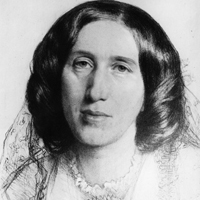Image and Symbols in Eliot's Adam Bede
Symbols and images play a pivotal role in the novel to impart the meaning the novelist intended. Some major symbols and imagery in Adam Bede are described below.

Mary Ann Evans (George Eliot)
The setting (Loamshire and Stonyshire) in the novel is a significant symbol. The symbolic representation of the places is opposite to their name and qualities. Loamshire is the major setting where most of the action takes place. The land of this area is fertile and soft. The weather for the crops like corn and grass is favorable and living is comfortable here. No poverty is noticed there as everything is abundant. But Stonyshire is barren and naked land where the lives of the poor are miserable in winter. As the land is not suitable for cultivation people depend on the earnings from working in the mines or in the mills.
The outward appearance and qualities of these two places are quite different, but the truth is that they bear inverse symbolic meaning. We learn the ugly aspect of the green and fertile Loamshire whereas even being barren and hard land Stonyshire is not completely a wasteland. Loamshire is perfectly represented by Hetty Sorrel who is beautiful and soft but inwardly she is hard, so hard that she leaves her newly born baby in the jungle to die and later does not accept the guilt easily. Loamshire is spiritually dead, though life is easier there. But the people of Stonyshire is religiously upright and have soft hearts. They are awake in the heart and spiritually they are in heaven.
The gates in the novel Adam Bede have symbolic meaning. The characters most often remain around the gates or pass through the gates outside the house or in the field. Whenever they pass through the gates or linger around the gates, some major changes take place in their lives. Hetty Sorrel passes through the gates to meet Captain Arthur Donnithorne, leaving the innocence and purity of childhood behind and moving ahead in the path of maturity. The gates outside the house stands for the privacy the characters want to maintain in their lives and in their heart. Whoever are permitted to enter through the gates are regarded as the family members and the secrets are revealed. While Adam enters into the gate of Hall Farm, he does not make any noise which refers to his respectable position. Whereas, when Donnithorne enter through the same gate, he makes unnecessary noise which symbolically refers to his arrogance, his misdeed and ultimately his shame.
The hearth and home too stand symbolically in the novel. Home and hearth have an implicit meaning of family love, unity and dependence on each other. It is the source of nourishment and a basic force in the lives of the characters. The hearth and home of the Poysers in Hall Farm is the most noticeable example in the novel. In each scene, the grandpa sits in front of the hearth and other family members sit around him. Many problems and tensions are discussed there and solutions are made around the hearth. At Adam Bede's home too, this hearth plays an important role. His mother spends most of her time in front of the hearth and Dinah is praised for her ability to keep clean and cook in the hearth. The strong and the praiseworthy characters spend their times around the hearth in the novel.
Arthur Donnithorne's white hand is a powerful color imagery Eliot has used. The white hand of Arthur symbolically stands for the Hellenistic tradition. His white hands are regarded as the representative of the Greek God of love and passion. His own moral flaws are the causes of his and Hetty Sorrel’s fall down. Whereas Dinah Morris and Adam Bede stand for the virtuous control over passion and emotional attraction towards sex.
Adam Bede’s last supper has another level of symbolic representation. When Hetty is in trail, Adam Bede cannot overcome the grief. Meanwhile the school master Bartle Massey brings bread and wine in an upper room for Adam. Adam’s growth of maturity to love and forgive Hetty even at the time of her unpardonable sin is described as baptism and rebirth.
Literary Spotlight
Introduction of Eliot's Adam Bede
Determinism in Eliot's Adam Bede
Social Realism in George Eliot's Adam Bede
Moral Concerns in Eliot's Adam Bede
Rustic Scenes in Eliot's Adam Bede
Narrative Technique in Eliot's Adam Bede
Study of Female Protagonist in Adam Bede
Comparative Study of Hetty and Hester
Multiple Themes in Eliot's Adam Bede
 |
bachelorandmaster.com |